BCE FM Blue GPS Tracker Review
Previously, trackers in the CIS market were only a few pieces, and it was quite easy to choose, but now dozens of manufacturers produce many versions. At the same time, of course, each new version has more and more advanced functionality, which makes the manufacturer more competitive in the market, and at the same time provides customers with more opportunities.
So, it’s getting harder and harder to understand these products of the competitive manufacturers, I’ll post a review of BCE FM Blue, a controller from Baltic car equipment (BCE), a Lithuanian manufacturer of electronic equipment for cars.

')
FM Blue is a GPS / GSM device that allows monitoring of mobile and stationary objects. The delivery package includes a central unit, wires for connection, external GPS and GSM antennas and a 1A fuse.
Determine the mode of operation of the device is quite convenient thanks to the LED display. Another unique advantage of BCE Blue is the complete absence of configuration slots, since the parameters are programmed via GPRS. In case you work with a large number of such controllers, on each of them, in addition to the IMEI-number, there is also a bar code that allows you to quickly and accurately register devices, which saves time.
From myself I note that when placing the central unit during the installation process, it is necessary to take into account the short length of the GPS cable and GSM antennas.
If it is quite prosaic to list the technical characteristics of the device:
Initially disappointed by the lack of a built-in battery. But later it turned out that in this model, it was provided by manufacturers, since Li-Ion or NiMh-battery, widely used in most devices on the market, has a very narrow temperature range, which is especially noticeable at temperatures below zero. Also, these batteries have a limited number of charge / discharge cycles. Thus, the use of acidic external batteries is a conscious choice of manufacturers, primarily because of their affordable prices, the lack of capacity limitations, as well as a wide temperature range.
The GSM module is one of the smallest modules in the world, a quad-band GSM / GPRS module Telit GE 865-QUAD . Despite its size, the module has an extended temperature range from -40 ° C to + 85 ° C and is known for its reliability and stability. The GPS receiver is a module from the Swiss company U-Blox, which has also proven itself in the market.

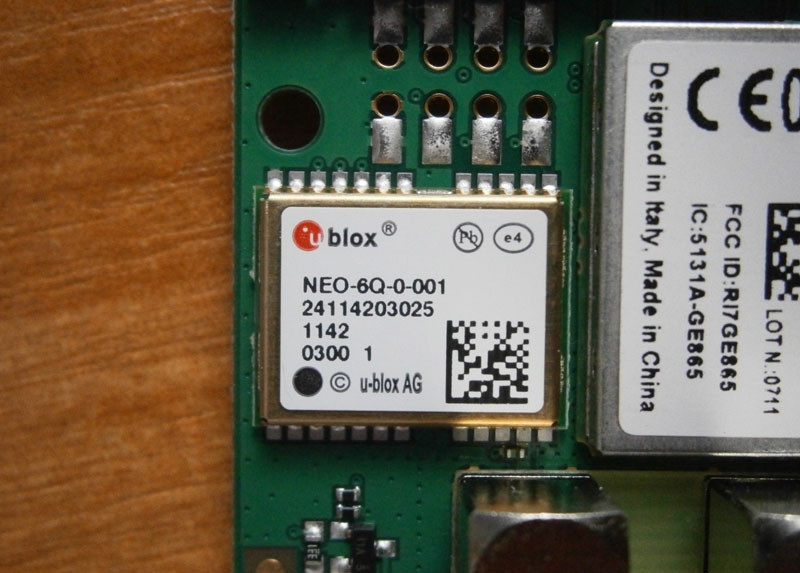
The NEO-6x GPS modules, made using u-blox 6 technology, are distinguished by their small size and low power consumption, so that these characteristics are important, I think everyone who works with m2m technologies will agree. The built-in low-noise LNA amplifier is designed for use with both active and passive antennas. Also, the Kick Start mode seemed very interesting, which makes it possible to carry out a “cold start” with a weak signal. The best result when testing for about 30 seconds - the device demonstrated in an open area.
I also liked the ability to configure the device so that it would automatically connect to the satellite every 20-30 minutes to download the actual data.
The obvious plus is the presence of the ATxmega256A3 microcontroller, which acts as a link between the GPS receiver, modem and peripheral devices, as well as the presence of a SIM card holder - Amphenol with gold-plated contacts.


Pleased and antenna connectors FAKRA . Connectors of different colors and with locks, so it is very difficult to get confused when connecting. The main Molex Micro-Fit connector provides both electrical and mechanical connection and seems to be very reliable.
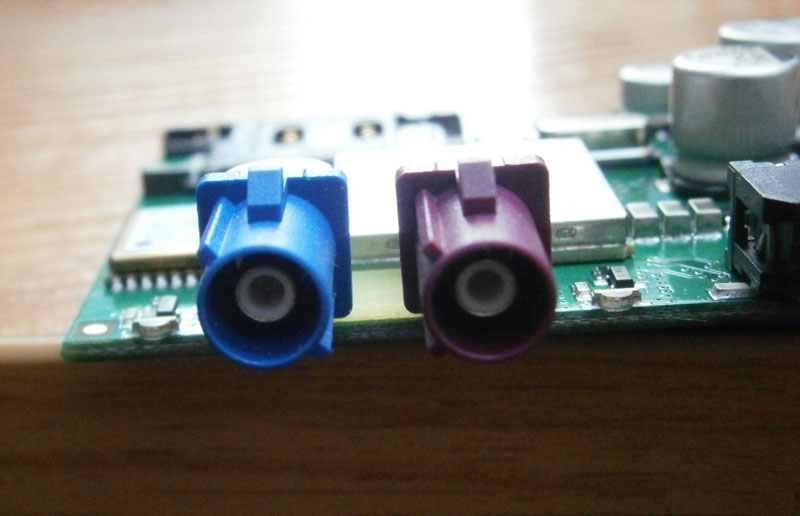
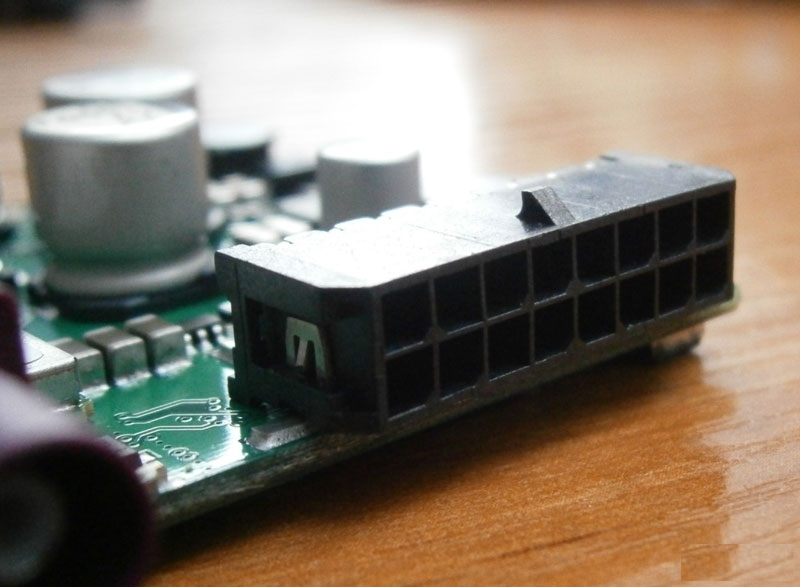
Micro-Fit and FAKRA are very convenient to seal, which means that the installers will not lose much time on this operation, which, I think, is also a plus.
The device has 4 digital inputs. Each of them can be used as a pulse counter, as well as a frequency meter. And although the measured frequency should not exceed 3 kHz, manufacturers declare that, if necessary, it can be increased to 12-15 kHz. Believe whether this is so I have not had the opportunity.
There are 3 analog inputs in the device (1 input up to 16 V and 2 inputs up to 36 V). ADC gives an error of about 1.5%. The device has 2 outputs (short-circuiting) and one output with a stable positive voltage. It may be useful to power an additional device, but the same pin is used to connect a backup power source, so two functions will not work at the same time, and it would be a pity. All outputs are controlled via SMS or GPRS.
It is also possible to connect fuel level sensors to the device (at the moment - up to 2 sensors via RS-232 or up to 4 sensors via RS-485).
Here are the protocols that BCE FM Blue supports:
As well as the 1-Wire interface (driver identification, the ability to connect temperature and humidity sensors). Of course, the number of supported protocols was impressive, it is not often seen on the market.
Convenient settings for sleep mode turned out to be very relevant. First, you can independently specify the criteria for transition to sleep mode and wake-up (vibration, external supply voltage, ignition, or any other digital input). And secondly, you can control the operation of GPS and GSM modules in sleep mode.
In addition to GPS data, the device also provides information received from GSM towers, including the distance to the tower. So the fact of moving the car can be fixed even if the GPS does not work. And if you accumulate a base of towers, then it will be possible in this way even to determine the location of the device, with a discount on the error, naturally.
The device transmits about 50 diagnostic codes (information on external voltage and current; changes in states and errors when connected to a GSM network, GPRS or server, the state of a GSM modem, etc.), which can be very useful in different situations.
The manufacturer also provided XML-settings for exporting already configured sensors to the objects of the Wialon monitoring system . Everyone can choose a sensor in accordance with the needs of their business solutions.
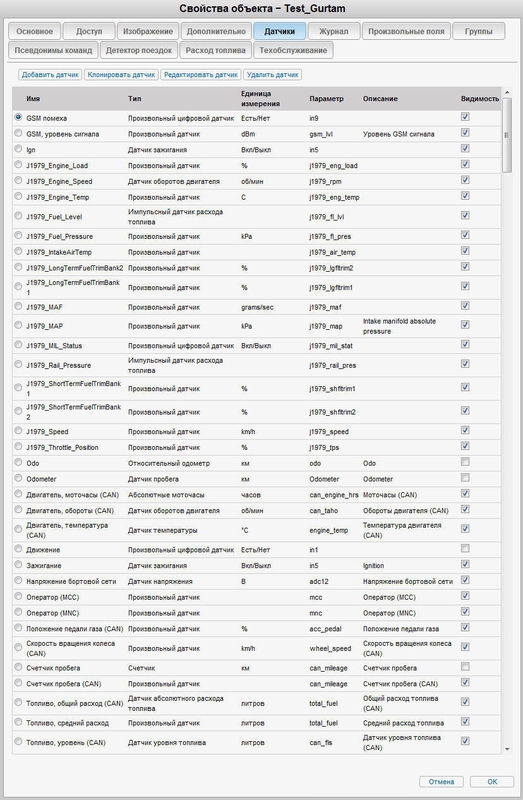
Well, of course, the data that, compared to devices such as Teltonika FM4200 or Ruptela FM Pro3A, turned out to be pleasant, the device yields a 50% savings on tarfik, or a little in the settings and the number of transmitted parameters.
BCE Configuration Manager turned out to be very convenient - a web server for accounting and configuration of ALL controllers. With it, you can add new devices, change firmware, parameters and settings for each tracker, create and edit lists of operators, relay data, and so on.

The idea is that changing all settings is done using GPRS, which allows you to simply insert a sim card into the module and plug it into the car, the service will automatically carry out all other settings. Another BCE Configuration Manager allows you to create groups of objects and change settings for them automatically, as well as create other users and delegate some rights to them.
All configurations can be edited independently in two modes: Simple mode and Advance mode.
It's nice to use Simple mode, which is obviously intended for visuals who are used to rearranging checkboxes and moving sliders. Of course, only 20% of the parameters can be changed in this mode, but they are used in 80% of the solutions, for implementing all standard functions, monitoring inputs and CAN is enough.
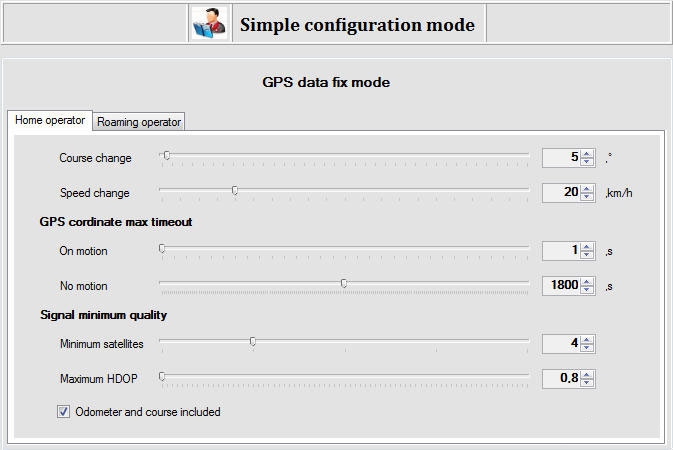

Advance Mode is more suitable for programmers or for very advanced users, which is quite difficult to use, but it can provide full access to tracker settings.
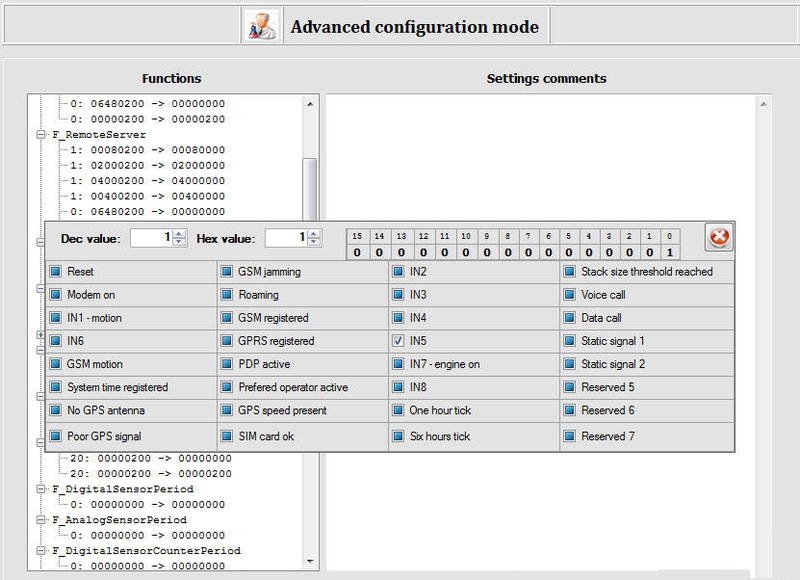
In the very concept of setting up equipment, EVERYTHING had to be dealt with additionally. The work is based on two key concepts: events and functions.

Events are:
List of the most useful events:
All events have discrete values.
Description of the functions:
It makes no sense to list the entire list of functions and settings, but here are some of the most useful ones:
An example of a set of values of the function of collecting points in time:
A list of priority operators can be stored in the device’s memory and connected to GSM networks in accordance with this list, that is, the higher the operator in the list, the more priority it is.
An example of a set of values of the function responsible for the availability and amount of data that the device records:
You can specify which parameters CAN and OBD will be formed under certain criteria or their combinations.
An example of a set of values of a function that opens a GPRS session:
As a result, you can use various events and their combinations to control the frequency of data collection and the schedule for sending to the server. It is also possible to establish an Internet connection not only in time, but also in accordance with other conditions.
And here are the specific tracks of movement:
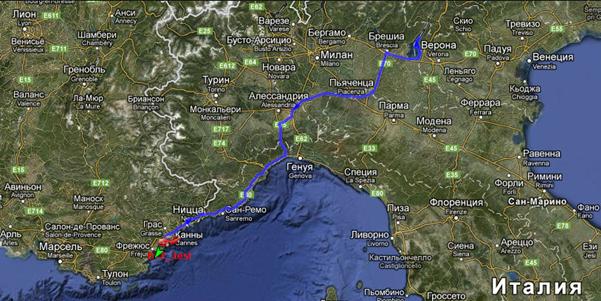

Minsk-Nice. Temperature +32 and crazy changes in humidity. As a result, no satellite fallout throughout the route.
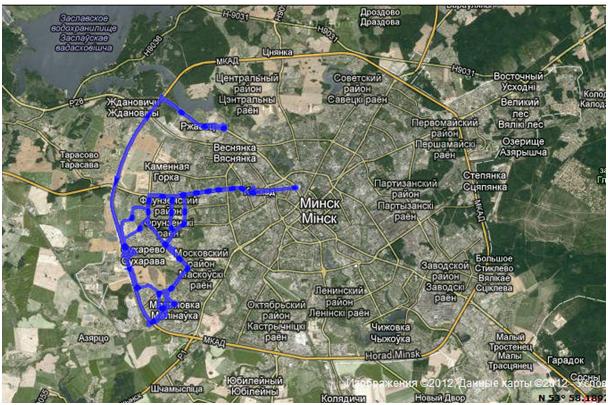
Detailed track within Minsk. Everything works perfectly.
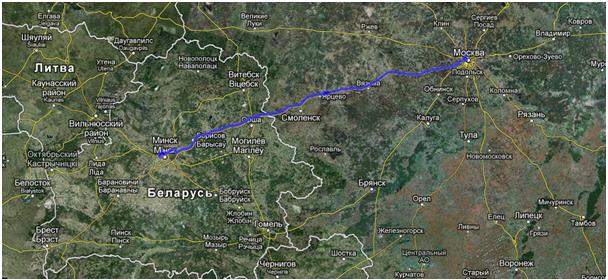

The classic route Minsk-Moscow - no loss of communication or freezes throughout the route.
In the end, I can say that the device is extremely functional and flexible to use. And of course, the low price is pleasantly surprising in combination with the economical consumption of traffic and enhanced functionality.
So, it’s getting harder and harder to understand these products of the competitive manufacturers, I’ll post a review of BCE FM Blue, a controller from Baltic car equipment (BCE), a Lithuanian manufacturer of electronic equipment for cars.

')
FM Blue is a GPS / GSM device that allows monitoring of mobile and stationary objects. The delivery package includes a central unit, wires for connection, external GPS and GSM antennas and a 1A fuse.
Determine the mode of operation of the device is quite convenient thanks to the LED display. Another unique advantage of BCE Blue is the complete absence of configuration slots, since the parameters are programmed via GPRS. In case you work with a large number of such controllers, on each of them, in addition to the IMEI-number, there is also a bar code that allows you to quickly and accurately register devices, which saves time.
From myself I note that when placing the central unit during the installation process, it is necessary to take into account the short length of the GPS cable and GSM antennas.
If it is quite prosaic to list the technical characteristics of the device:
- The sizes (VhShhG) - 26 x 80 x 55 mm.
- Weight - about 73 g.
- Operating temperature / storage temperature range - from -40? up to +85? C.
- Power supply - 6–34 V, minimum 10 V at startup.
- The current consumption: in active mode at 12V - less than 50 mA, in standby mode, less than 8 mA.
- Pulse protection - up to 120 V.
- Power outage logs in the event log.
- 4 digital inputs.
- 1 x ADC - 0-16 V, 11 bits.
- 2 x ADC - 0-36 V, 11 bits.
- 2 digital outputs.
- CAN interface J1939 (FMS), J1979 (OBDII).
- 1-WIRE interface.
- RS-232 / RS485 interface.
- Ability to connect an external battery (Pb, 12V).
Initially disappointed by the lack of a built-in battery. But later it turned out that in this model, it was provided by manufacturers, since Li-Ion or NiMh-battery, widely used in most devices on the market, has a very narrow temperature range, which is especially noticeable at temperatures below zero. Also, these batteries have a limited number of charge / discharge cycles. Thus, the use of acidic external batteries is a conscious choice of manufacturers, primarily because of their affordable prices, the lack of capacity limitations, as well as a wide temperature range.
The GSM module is one of the smallest modules in the world, a quad-band GSM / GPRS module Telit GE 865-QUAD . Despite its size, the module has an extended temperature range from -40 ° C to + 85 ° C and is known for its reliability and stability. The GPS receiver is a module from the Swiss company U-Blox, which has also proven itself in the market.


The NEO-6x GPS modules, made using u-blox 6 technology, are distinguished by their small size and low power consumption, so that these characteristics are important, I think everyone who works with m2m technologies will agree. The built-in low-noise LNA amplifier is designed for use with both active and passive antennas. Also, the Kick Start mode seemed very interesting, which makes it possible to carry out a “cold start” with a weak signal. The best result when testing for about 30 seconds - the device demonstrated in an open area.
I also liked the ability to configure the device so that it would automatically connect to the satellite every 20-30 minutes to download the actual data.
The obvious plus is the presence of the ATxmega256A3 microcontroller, which acts as a link between the GPS receiver, modem and peripheral devices, as well as the presence of a SIM card holder - Amphenol with gold-plated contacts.


Pleased and antenna connectors FAKRA . Connectors of different colors and with locks, so it is very difficult to get confused when connecting. The main Molex Micro-Fit connector provides both electrical and mechanical connection and seems to be very reliable.


Micro-Fit and FAKRA are very convenient to seal, which means that the installers will not lose much time on this operation, which, I think, is also a plus.
The device has 4 digital inputs. Each of them can be used as a pulse counter, as well as a frequency meter. And although the measured frequency should not exceed 3 kHz, manufacturers declare that, if necessary, it can be increased to 12-15 kHz. Believe whether this is so I have not had the opportunity.
There are 3 analog inputs in the device (1 input up to 16 V and 2 inputs up to 36 V). ADC gives an error of about 1.5%. The device has 2 outputs (short-circuiting) and one output with a stable positive voltage. It may be useful to power an additional device, but the same pin is used to connect a backup power source, so two functions will not work at the same time, and it would be a pity. All outputs are controlled via SMS or GPRS.
It is also possible to connect fuel level sensors to the device (at the moment - up to 2 sensors via RS-232 or up to 4 sensors via RS-485).
Here are the protocols that BCE FM Blue supports:
- J1939 (CAN-interface) - the well-known FMS for trucks.
- The J1708 (RS-485 interface) is the predecessor of J1939. It is useful if you want to see fuel data on Renault and Volvo trucks. Attention: support of this protocol will be implemented in one of the nearest firmware versions.
- OBD2 (CAN-interface) - diagnostic protocol for passenger cars (allows to obtain data on engine speed, coolant temperature, engine diagnostics, fuel pressure, air temperature, and other useful diagnostic information).
As well as the 1-Wire interface (driver identification, the ability to connect temperature and humidity sensors). Of course, the number of supported protocols was impressive, it is not often seen on the market.
Convenient settings for sleep mode turned out to be very relevant. First, you can independently specify the criteria for transition to sleep mode and wake-up (vibration, external supply voltage, ignition, or any other digital input). And secondly, you can control the operation of GPS and GSM modules in sleep mode.
In addition to GPS data, the device also provides information received from GSM towers, including the distance to the tower. So the fact of moving the car can be fixed even if the GPS does not work. And if you accumulate a base of towers, then it will be possible in this way even to determine the location of the device, with a discount on the error, naturally.
The device transmits about 50 diagnostic codes (information on external voltage and current; changes in states and errors when connected to a GSM network, GPRS or server, the state of a GSM modem, etc.), which can be very useful in different situations.
The manufacturer also provided XML-settings for exporting already configured sensors to the objects of the Wialon monitoring system . Everyone can choose a sensor in accordance with the needs of their business solutions.

Well, of course, the data that, compared to devices such as Teltonika FM4200 or Ruptela FM Pro3A, turned out to be pleasant, the device yields a 50% savings on tarfik, or a little in the settings and the number of transmitted parameters.
BCE Configuration Manager turned out to be very convenient - a web server for accounting and configuration of ALL controllers. With it, you can add new devices, change firmware, parameters and settings for each tracker, create and edit lists of operators, relay data, and so on.

The idea is that changing all settings is done using GPRS, which allows you to simply insert a sim card into the module and plug it into the car, the service will automatically carry out all other settings. Another BCE Configuration Manager allows you to create groups of objects and change settings for them automatically, as well as create other users and delegate some rights to them.
All configurations can be edited independently in two modes: Simple mode and Advance mode.
It's nice to use Simple mode, which is obviously intended for visuals who are used to rearranging checkboxes and moving sliders. Of course, only 20% of the parameters can be changed in this mode, but they are used in 80% of the solutions, for implementing all standard functions, monitoring inputs and CAN is enough.


Advance Mode is more suitable for programmers or for very advanced users, which is quite difficult to use, but it can provide full access to tracker settings.

In the very concept of setting up equipment, EVERYTHING had to be dealt with additionally. The work is based on two key concepts: events and functions.

Events are:
- Uncontrollable (for example, roaming mode setting on a SIM card, loss of a GSM signal, time synchronization by a device, etc.) - these events occur regardless of the settings and are associated only with signal quality and / or other external circumstances.
- Conditionally controlled (turning off the GPS antenna, triggering inputs on the device, connecting to a priority GSM-operator) - these events depend on physical actions in relation to the device and its inputs.
- Functions controlled (vibration and motion, speeding, GPRS connection setup, weak GPS signal, vehicle generator operation, etc.) - these events depend on the equipment settings and trigger when the value of some internal variable parameter coincides with the value or level , which was set in the settings (in this case, these values and criteria for controlling parameters are set by special functions).
List of the most useful events:
- device modem is turned on;
- movement of the car is defined (conditions are set by the corresponding function);
- turn off the GPS antenna;
- weak GPS signal (conditions are configured by the corresponding functions);
- GSM signal is muted (more than 80% of the signal);
- roaming mode of the SIM card;
- GPRS installed;
- created TCP socket (established connection to the server);
- speeding is fixed (the limit is set by the corresponding function);
- A SIM card works for a priority operator (less expensive, for example, and the lists of priority operators themselves can be created and edited quickly in the web interface);
- The necessary amount of data for sending is collected (set by the corresponding function, thus it is possible to configure the settings so that the size of the package to be sent always meets the detailed conditions on the GSM operator’s tariff plan).
All events have discrete values.
Description of the functions:
- All functions have their own values.
- The values of the functions may depend on a set of events (various combinations of them).
- The degree of dependence of the function values on the event: 'true', 'false', 'don't care'.
- The function values may be constant and not at all dependent on events.
- Depending on the conditions (set of events) there may be several values of the function.
- Some functions are designed to manage events (i.e., to change the state of an event under certain conditions and other events)
It makes no sense to list the entire list of functions and settings, but here are some of the most useful ones:
An example of a set of values of the function of collecting points in time:
- 30 minutes - parking, sim card in the home network;
- 1 hour - parking, roaming;
- 1 minute - movement, SIM card in the home network;
- 5 minutes - movement, roaming, connection to the priority operator;
- 10 minutes - movement, roaming, no connection to the priority operator.
A list of priority operators can be stored in the device’s memory and connected to GSM networks in accordance with this list, that is, the higher the operator in the list, the more priority it is.
An example of a set of values of the function responsible for the availability and amount of data that the device records:
- GPS + LLS - when parked.
- GPS + CAN (OBD) + LLS - in motion.
- GPS - with the engine stopped.
- GPS + frequency reading at the inputs + LLS - when the engine is running.
You can specify which parameters CAN and OBD will be formed under certain criteria or their combinations.
An example of a set of values of a function that opens a GPRS session:
- 10 minutes - move, SIM card in the home network.
- 20 minutes - movement, roaming, connection to the priority operator.
- 40 minutes - roaming traffic, no connection to the priority operator.
- 1 hour - parking, roaming, connection to the priority operator.
- 4 hours - parking, roaming, no connection to the priority operator.
- 5 minutes - movement, roaming, the volume of the data packet is equal to the amount of detail.
- 30 sec - SIM card in home network, GPS antenna is disabled.
As a result, you can use various events and their combinations to control the frequency of data collection and the schedule for sending to the server. It is also possible to establish an Internet connection not only in time, but also in accordance with other conditions.
And here are the specific tracks of movement:


Minsk-Nice. Temperature +32 and crazy changes in humidity. As a result, no satellite fallout throughout the route.

Detailed track within Minsk. Everything works perfectly.


The classic route Minsk-Moscow - no loss of communication or freezes throughout the route.
In the end, I can say that the device is extremely functional and flexible to use. And of course, the low price is pleasantly surprising in combination with the economical consumption of traffic and enhanced functionality.
Source: https://habr.com/ru/post/148016/
All Articles